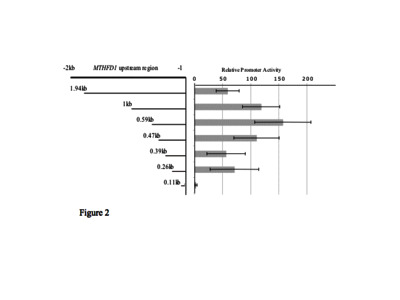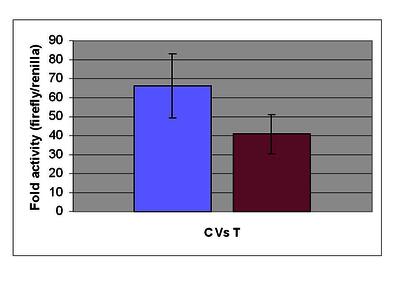Carroll, Nicola, Pangilinan, Faith, Molloy, Anne M., Troendle, James, Mills, James L., Kirke, Peadar N., Brody, Lawrence C., Scott, John M. and Parle-McDermott, Anne  ORCID: 0000-0002-1533-3209
(2009)
Analysis of the MTHFD1 promoter and risk of neural tube defects.
Human Genetics, 125
(3).
pp. 247-256.
ISSN 1913-0090
ORCID: 0000-0002-1533-3209
(2009)
Analysis of the MTHFD1 promoter and risk of neural tube defects.
Human Genetics, 125
(3).
pp. 247-256.
ISSN 1913-0090
Abstract
Genetic variants in MTHFD1 (5,10-methylenetetrahydrofolate dehydrogenase/5,10-methenyltetrahydrofolate cyclohydrolase/ 10-formyltetrahydrofolate synthetase), an important folate metabolic enzyme, are associated with a number of common diseases, including neural tube defects (NTDs). This study investigates the promoter of the human MTHFD1 gene in a bid to understand how this gene is controlled and regulated. Following a combination of in silico and molecular approaches, we report that MTHFD1 expression is controlled by a TATA-less, Initiator-less promoter and transcription is initiated at multiple start sites over a 126 bp region. We confirmed the presence of three database polymorphisms (dbSNP) by direct sequencing of the upstream region (rs1076991 C > T, rs8010584 G > A, rs4243628 G > T), with a fourth (dbSNP rs746488 A > T) not found to be polymorphic in our population and no novel polymorphisms identified. We demonstrate that a common SNP rs1076991 C > T within the window of transcriptional initiation exerts a significant effect on promoter activity in vitro. We investigated this SNP as a potential risk factor for NTDs in a large homogenous Irish population and determined that it is not an independent risk factor, but, it does increase both case (χ 2 = 11.06, P = 0.001) and maternal (χ 2 = 6.68, P = 0.01) risk when allele frequencies were analysed in combination with the previously identified disease-associated p.R653Q (c.1958 G > A; dbSNP rs2236225) polymorphism. These results provide the first insight into how MTHFD1 is regulated and further emphasise its importance during embryonic development.
Metadata
| Item Type: | Article (Published) |
|---|---|
| Refereed: | Yes |
| Additional Information: | The original publication is available at www.springerlink.com |
| Uncontrolled Keywords: | MTHFD1; NTD; Functional SNP; R653Q; Promoter; Folate; Folic acid; Spina Bifida; |
| Subjects: | Biological Sciences > Genetics |
| DCU Faculties and Centres: | DCU Faculties and Schools > Faculty of Science and Health > School of Biotechnology |
| Publisher: | Springer Berlin / Heidelberg |
| Official URL: | http://dx.doi.org/10.1007/s00439-008-0616-3 |
| Use License: | This item is licensed under a Creative Commons Attribution-NonCommercial-Share Alike 3.0 License. View License |
| Funders: | Intramural research Programme of NICHD, NIH, US, Health Research Board |
| ID Code: | 2965 |
| Deposited On: | 16 Mar 2009 12:34 by Anne Parle-Mcdermott . Last Modified 16 Feb 2022 15:44 |
Documents
Full text available as:
Preview |
PDF
- Requires a PDF viewer such as GSview, Xpdf or Adobe Acrobat Reader
263kB |
| Image (GIF) (Fig 1) | |
![[thumbnail of Fig 2]](https://doras.dcu.ie/2965/4.hassmallThumbnailVersion/Fig2Carrolletal.gif)  Preview |
Image (GIF) (Fig 2)
8kB |
![[thumbnail of Fig 3]](https://doras.dcu.ie/2965/5.hassmallThumbnailVersion/Fig3Carrolletal.jpg)  Preview |
Image (JPEG) (Fig 3)
44kB |
Preview |
PDF
- Requires a PDF viewer such as GSview, Xpdf or Adobe Acrobat Reader
251kB |
Preview |
PDF
- Requires a PDF viewer such as GSview, Xpdf or Adobe Acrobat Reader
356kB |
Downloads
Downloads
Downloads per month over past year
Archive Staff Only: edit this record